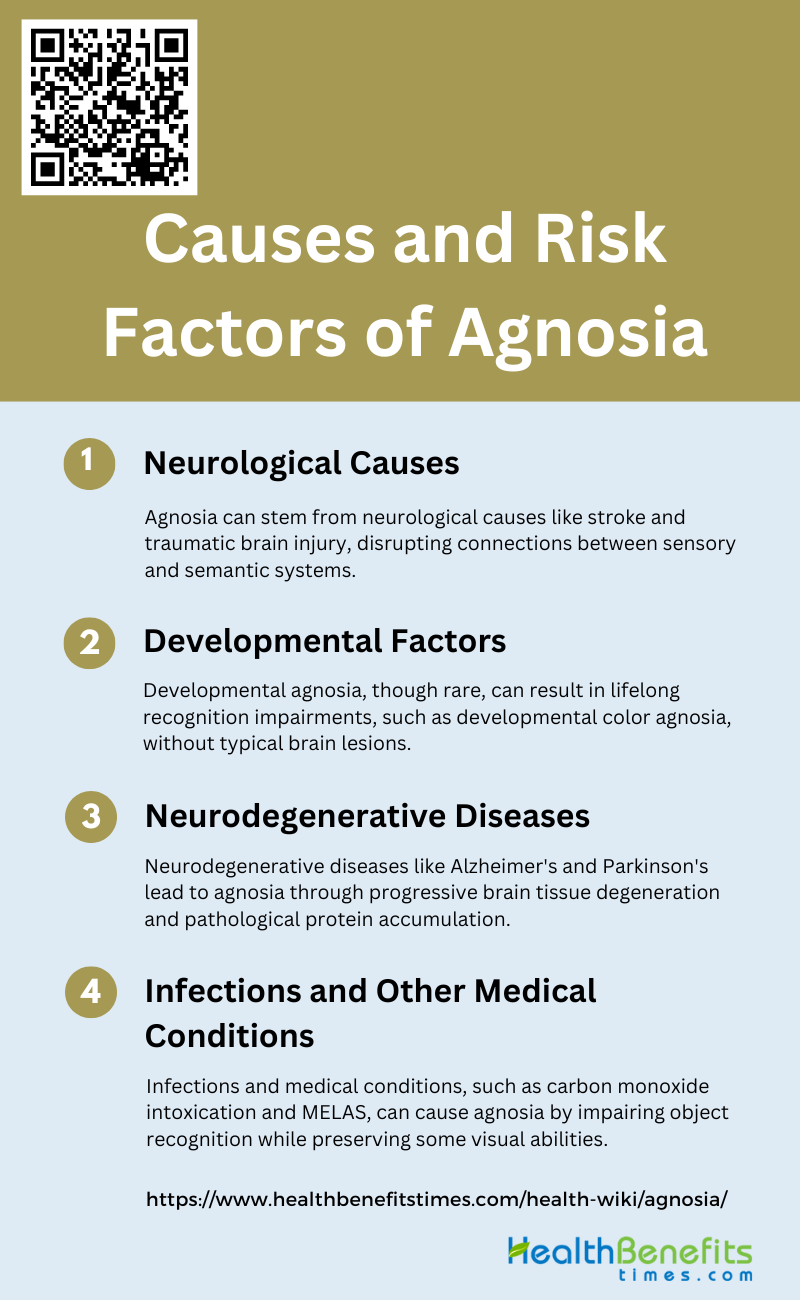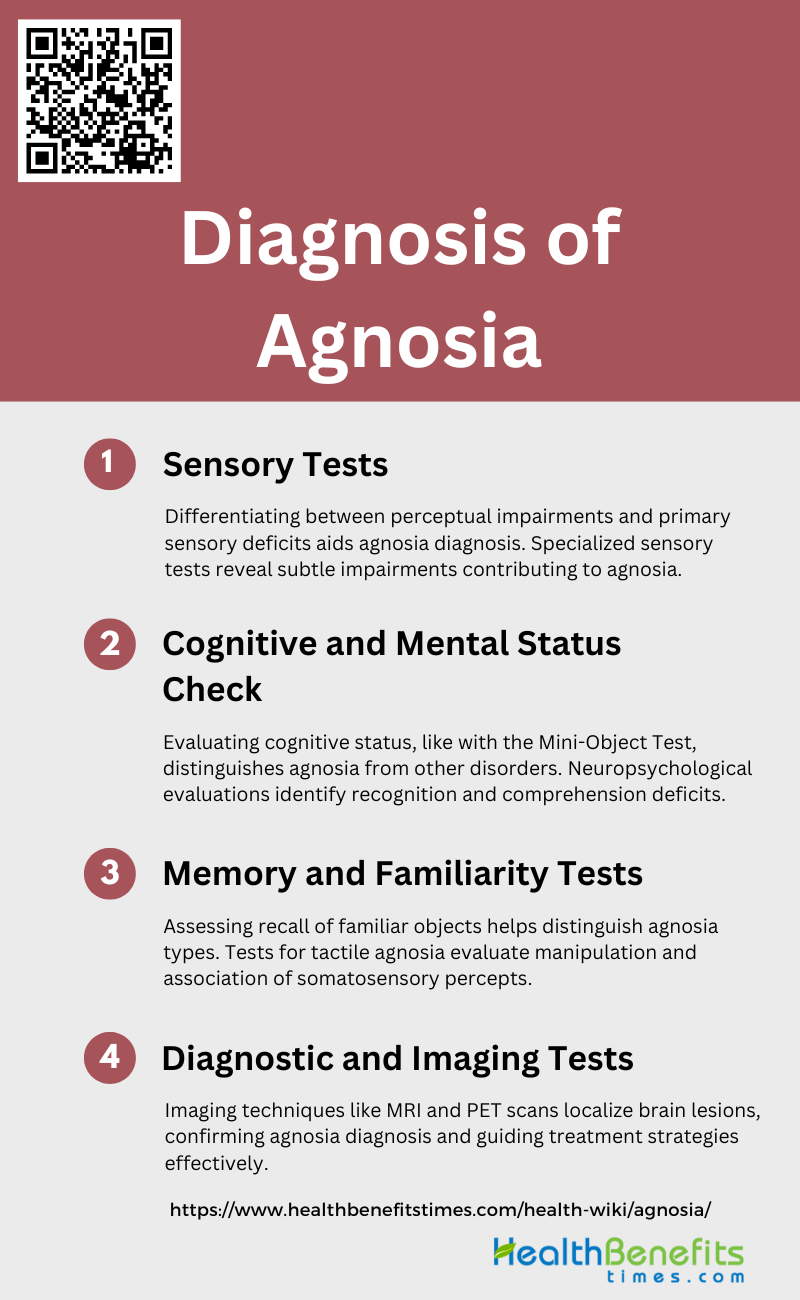Agnosia is a rare neurological disorder characterized by the inability to recognize familiar objects, people, sounds, or smells despite having intact sensory functions. It is caused by damage or dysfunction in specific brain regions responsible for processing and integrating sensory information with stored knowledge and memories. In agnosia, the affected individual can perceive the sensory stimuli (e.g., see an object, hear a sound) but cannot identify or comprehend its meaning or significance, even though their memory, attention, and language abilities remain intact. The type of agnosia depends on the sensory modality affected, such as visual agnosia (inability to recognize objects or faces), auditory agnosia (inability to recognize sounds or voices), or tactile agnosia (inability to recognize objects through touch).
Types of Agnosia
Here are the main types of agnosia that illustrate the diverse ways in which this cognitive impairment can affect individuals.
1. Visual Agnosia
Visual agnosia is a neurological disorder characterized by the inability to recognize objects through sight, despite having intact visual sensory functions. This condition is not due to deficits in memory, attention, or language. Visual agnosia can be categorized into three types: apperceptive, associative, and asemantic. Apperceptive visual agnosia involves difficulties in processing visual information, leading to errors in object recognition due to bilateral occipito-temporal cortex lesions. Associative visual agnosia is marked by the inability to link visual perceptions with their meanings, often due to unilateral lesions in the left gyrus angularis. Asemantic visual agnosia involves a loss of the meanings of objects and words, typically associated with bilateral temporo-limbic cortex damage. Studies have shown that visual agnosia can also be linked to neurofibrillary tangles in visual association cortex in Alzheimer’s disease.
2. Auditory Agnosia
Auditory agnosia is a condition where individuals cannot recognize or differentiate sounds despite having normal hearing abilities. This disorder often results from bilateral temporal lobe lesions, although unilateral lesions can also be implicated. Auditory agnosia can be divided into subtypes based on the nature of the auditory material affected. For instance, some patients may have difficulty recognizing linguistic sounds, while others may struggle with non-linguistic sounds. The condition often arises from repeated insults to the auditory processing areas of the brain, leading to a disruption in the interhemispheric functional relationships. The principle of contralateral compensation and lesional interference are key concepts in understanding the underlying mechanisms of auditory agnosia.
3. Tactile Agnosia
Tactile agnosia is the inability to recognize objects through touch, despite having intact somatosensory functions. This condition can result from lesions in the left inferior parietal cortex, including Brodmann areas 39 and 40. Tactile agnosia can be further divided into primary and secondary types. Primary tactile agnosia involves a deficit in perceiving the tactile qualities of an object, such as its size, shape, and texture, while secondary tactile agnosia is characterized by the inability to recognize an object’s meaning despite being able to perceive its sensory features. Historical case studies, such as those by Josef Gerstman and Carl Wernicke, have contributed significantly to our understanding of tactile agnosia, highlighting the importance of the postcentral gyrus and the disconnection of tactile image centers from other sensory areas.
Causes and Risk Factors of Agnosia
Below is a list of the primary causes and risk factors associated with the development of agnosia.
1. Neurological Causes
Agnosia can result from various neurological causes, including stroke and brain injury. For instance, ischemic strokes affecting the posterior cerebral artery can lead to visual agnosia by disrupting the connection between visual memory and the semantic system, as seen in a patient who developed severe visual agnosia following such a stroke. Traumatic brain injury (TBI) is another significant neurological cause, with moderate to severe TBI increasing the risk of neurodegenerative diseases, which can manifest as different forms of agnosia. The acute and chronic processes following TBI, such as axonal injury and neuroinflammation, contribute to the development of pathological proteins that may lead to neurodegeneration and associated cognitive deficits.
2. Developmental Factors
Developmental factors can also play a role in the onset of agnosia. Although less common than acquired forms, developmental agnosia can occur, as illustrated by a case of developmental color agnosia. This condition involves the inability to recognize colors despite intact color perception and semantic memory for color information. The patient in this case had a lifelong inability to name colored patches, suggesting a developmental origin of the agnosia, which was confirmed by the absence of brain lesions typically associated with acquired color agnosia. Such cases highlight the importance of considering developmental anomalies in the diagnosis and understanding of agnosia.
3. Neurodegenerative Diseases
Neurodegenerative diseases are a prominent cause of agnosia. Conditions like Alzheimer’s disease (AD) and Parkinson’s disease (PD) are closely associated with aging and involve the progressive degeneration of brain tissues, leading to various cognitive impairments, including agnosia. The biological mechanisms underlying these diseases, such as genomic instability, mitochondrial dysfunction, and cellular senescence, contributes to the susceptibility to neurodegenerative diseases and their associated symptoms. The progression of these diseases often results in the accumulation of pathological proteins, which disrupt normal brain function and lead to cognitive deficits, including different forms of agnosia.
4. Infections and Other Medical Conditions
Infections and other medical conditions can also lead to agnosia. For example, conditions like carbon monoxide intoxication and mitochondrial encephalopathy, lactic acidosis, and stroke-like syndrome (MELAS) have been linked to visual agnosia. Patients with these conditions often exhibit impaired object recognition while maintaining some visual perceptual abilities, such as form discrimination and mental rotation. These cases suggest that disturbances in parallel distributed processing within the brain can lead to agnosia. Additionally, raised intracranial pressure and diffuse cerebral arteriosclerosis can complicate the diagnosis and evaluation of agnosia, as these conditions often present with a range of cognitive and perceptual disturbances.
Diagnosis of Agnosia
The diagnosis of agnosia, a complex neurological disorder characterized by the inability to recognize and process sensory information, is a multi-step process. Clinicians must carefully differentiate it from other cognitive impairments through a series of assessments. Below is a list of key diagnostic criteria and methods used to identify agnosia:
1. Sensory Tests
Sensory tests are crucial in diagnosing agnosia as they help differentiate between higher-order perceptual impairments and primary sensory deficits. For instance, Ettlinger’s study highlighted that agnosia could not be solely attributed to lower-level visual impairments, as patients with severe perceptual issues did not necessarily exhibit recognition deficits. Similarly, Bay’s research emphasized the importance of specialized sensory tests to detect subtle visual impairments that might contribute to agnosia, even when routine examinations show normal results. Detailed somesthetic testing, as demonstrated in a case study of tactile agnosia, can reveal high-level perceptual process faults while preserving the ability to associate objects with episodic memory.
2. Cognitive and Mental Status Check
Evaluating cognitive and mental status is essential in diagnosing agnosia, particularly in differentiating it from other cognitive disorders. The Mini-Object Test (MOT) has been validated as a reliable and cost-effective screening tool for assessing cognitive impairments associated with agnosia, aphasia, and apraxia in patients with Alzheimer’s disease. This test is particularly useful in settings where patients may have limited attention spans or other cognitive limitations. Additionally, neuropsychological evaluations, such as those used in diagnosing auditory agnosia, can help assess overall cognitive function and identify specific deficits in recognition and comprehension.
3. Memory and Familiarity Tests
Memory and familiarity tests are vital in distinguishing between different types of agnosia and other cognitive disorders. Associative agnosia, for example, involves the inability to attribute meaning to a correctly perceived stimulus, which can be assessed through tests that evaluate the patient’s ability to recognize and recall familiar objects, faces, and colors. In cases of tactile agnosia, tests that assess the manipulation of somatosensory percepts and their association with previous knowledge can help determine the extent of the impairment and its impact on memory and recognition. These tests are crucial for understanding the cognitive architecture underpinning recognition and for identifying the specific nature of the agnosia.
4. Diagnostic and Imaging Tests
Diagnostic and imaging tests play a critical role in identifying the underlying causes of agnosia and localizing brain lesions. Advanced imaging techniques, such as tau PET scans, have been used to diagnose tauopathies in patients with auditory agnosia, revealing specific areas of brain atrophy and hypoperfusion. MRI and single-photon emission computed tomography (SPECT) can also provide detailed images of brain structures, helping to identify lesions in regions associated with different types of agnosia, such as the occipitotemporal region for visual agnosia. These imaging tests are essential for confirming the diagnosis and guiding treatment strategies.
Treatment and Management for Agnosia
Agnosia presents unique challenges in treatment and management, as it involves the loss of the ability to recognize and interpret sensory information. Addressing this neurological disorder requires a multidisciplinary approach tailored to the specific type of agnosia and the individual needs of the patient. Below is a list of strategies and therapies commonly employed in the treatment and management of agnosia.
1. Medications
Currently, there is limited evidence supporting the use of medications specifically for the treatment of agnosia. Most therapeutic approaches focus on non-pharmacological interventions. However, medications may be used to manage underlying conditions that contribute to agnosia, such as stroke or traumatic brain injury. For instance, neuroprotective agents and drugs that enhance cognitive function might be prescribed to support overall brain health and potentially improve symptoms indirectly. Further research is needed to explore the potential benefits of pharmacological treatments directly targeting agnosia.
2. Surgery
Surgical interventions are not typically a primary treatment option for agnosia. However, in cases where agnosia is caused by a brain tumor or other structural abnormalities, surgical removal of the lesion may be considered. The success of such interventions depends on the location and nature of the lesion. Neuroimaging tools have been instrumental in identifying the loci of lesions that cause various types of agnosia, which can guide surgical planning and improve outcomes. Nonetheless, surgery is generally reserved for cases where non-invasive treatments are ineffective or when the agnosia is secondary to a treatable structural cause.
3. Therapy and Rehabilitation
Therapy and rehabilitation is the cornerstone of agnosia management. Various approaches, including compensatory strategies and restorative training, have shown promise. For example, compensatory strategies, such as teaching patients to use alternative sensory modalities, have been beneficial in managing visual agnosia and Balint’s syndrome. Restorative training, which aims to improve the impaired cognitive functions, has produced mixed results but remains a critical area of research. Speech therapy and cognitive rehabilitation have also been effective, particularly in cases of auditory agnosia, helping patients regain some level of verbal comprehension and communication skills. Overall, a multidimensional approach combining different therapeutic modalities is recommended for optimal outcomes.
Prevention of Agnosia
Agnosia, the inability to recognize and interpret sensory information, can have a profound impact on daily life. While it’s not always preventable, understanding and addressing the risk factors may reduce the likelihood of its occurrence. Here are several strategies that could potentially help in the prevention of agnosia:
1. Eat a balanced diet and maintain a healthy weight
Maintaining a balanced diet and a healthy weight is crucial for overall brain health and can help prevent cognitive disorders such as agnosia. Nutrient-rich foods provide essential vitamins and minerals that support brain function. For instance, a diet high in antioxidants, omega-3 fatty acids, and other essential nutrients can reduce inflammation and oxidative stress, which are linked to cognitive decline. Additionally, maintaining a healthy weight reduces the risk of conditions like diabetes and hypertension, which are known to negatively impact brain health. Research has shown that traditional Chinese herbal medicines, such as polysaccharides from Agaricus blazei, can also play a role in disease prevention and overall health maintenance.
2. Don’t ignore infections
Ignoring infections can have severe consequences for brain health, potentially leading to conditions like agnosia. Infections can cause inflammation and damage to brain tissues, which may impair cognitive functions. For example, the use of nano Ag/ZnO-incorporated hydroxyapatite composite coatings on implants has been shown to prevent infections effectively. These coatings release antibacterial agents that inhibit the growth of harmful bacteria such as Escherichia coli and Staphylococcus aureus, thereby reducing the risk of infection and subsequent inflammation. By addressing infections promptly, one can prevent the long-term cognitive impairments associated with untreated infections.
3. Wear safety equipment
Wearing safety equipment is essential to prevent head injuries, which can lead to cognitive disorders like agnosia. Head injuries can cause significant damage to brain tissues, leading to various cognitive impairments. Safety equipment such as helmets, seat belts, and protective gear can mitigate the risk of traumatic brain injuries. For instance, in medical settings, the use of advanced materials like nano Ag/ZnO-incorporated hydroxyapatite composite coatings on implants not only prevents infections but also promotes osteointegration, ensuring the stability and safety of the implants. Thus, wearing appropriate safety equipment is a proactive measure to protect brain health.
4. Manage your health conditions
Managing existing health conditions is vital for preventing cognitive disorders such as agnosia. Chronic conditions like diabetes, hypertension, and cardiovascular diseases can adversely affect brain health if not properly managed. Effective management of these conditions involves regular monitoring, medication adherence, and lifestyle modifications. For example, incorporating traditional Chinese herbal medicines, such as the polysaccharide ABP-Ia from Agaricus blazei, has been shown to inhibit the proliferation of cancer cells and promote apoptosis, thereby contributing to overall health maintenance. By managing health conditions effectively, one can reduce the risk of cognitive decline and maintain optimal brain function.





